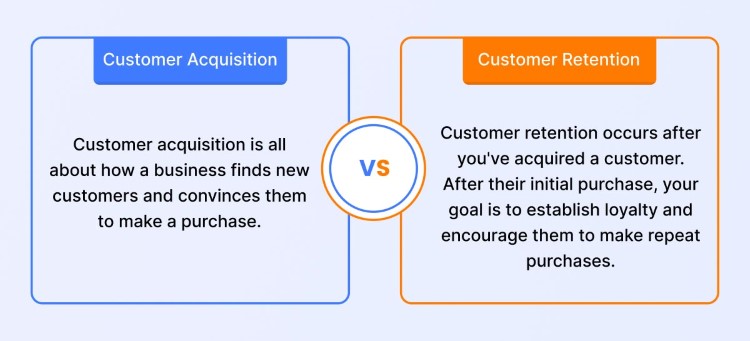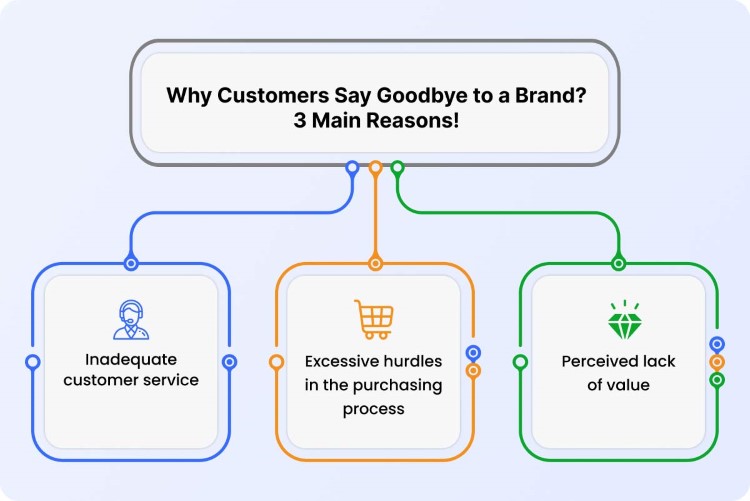Top 10 Customer Retention Software for 2025
- November 7, 2023
- 19 mins read
- Listen

The sound of “ka-ching” resonates in your mind upon selling a product to a new customer does not signify the completion of your job. On the contrary, it’s just the beginning. Maintaining your newly acquired customers over an extended period is a continuous effort and far from simple. Rather than relying on guesswork to determine which retention strategies are effective, it is advisable to utilize customer retention management software as a valuable tool to steer you in the right direction.
Allocating resources to effective product marketing can draw new customers to the doorstep of your online store. However, research indicates that approximately 13% of dissatisfied customers will spread the word about their negative experiences to more than 20 individuals. The essential strategy lies in retaining your current customers and diligently working to transform them into repeat clients. This is why businesses are making significant investments in top-notch customer retention software.
The year 2025 brings a wealth of remarkable software solutions designed to enhance customer retention and loyalty. As it becomes more important to build strong customer relationships, businesses need to keep communicating with customers at critical points in their journey.
This guide will explore in greater detail some of the leading customer retention software options tailored to different business scales. Keep reading!
Understanding Customer Retention
Customer retention definition refers to as a ‘business’s capacity to maintain its current customers and sustain a revenue stream from them. Businesses employ various strategies to transform initial buyers into recurring customers.’
Essentially, customer retention enables a business to enhance the profitability of an existing customer and optimize its long-term value. Consider customer retention as a procedure through which a business tries to persuade its current customers to continue buying its products or services. This differs from lead generation, which focuses on obtaining contact details from companies or individuals who are potential purchasers and have yet to make a purchase.
On the contrary, customer retention is centered on the current customer base. The objective is to boost repeat purchases by cultivating customer loyalty through exceptional customer service, product value, and a unique edge over comparable products or services.
Why Retaining Customers is So Important?
Maintaining customer retention plays a pivotal role in fostering repeat purchases and continuous value from your customer pool. A frequently mentioned guideline suggests that acquiring a new customer costs about five times more than retaining an existing one. To enhance customer retention, two vital factors include gaining customer satisfaction and loyalty. Additionally, businesses must recognize any practices that could deter both potential and current customers, such as sluggish or subpar customer service or defective products.
The primary advantage of customer retention is the potential to optimize the revenue derived from each customer. Moreover, there are additional benefits, like:
-
Higher Profits
Several businesses derive the majority of their income from their existing customer base. According to a BIA/Kelsey report, 61% of small and medium-sized businesses affirmed this trend. Therefore, prioritizing this aspect of your business is of utmost importance. This approach not only enhances your revenue but also increases your business’s overall profitability.
-
Reduced Expenses
As reported by Bain & Company, retaining an existing customer is considerably more cost-effective in the long term, ranging from 5 to 25 times cheaper than acquiring a new one.
-
Enhanced Average Order Value (AOV)
Returning customers often exhibit a tendency to elevate their spending gradually, thereby boosting their average order value. This is precisely why a mere 5% improvement in retention rate, as reported by Bain & Company, can result in profit expansion ranging from 25% to 95%. Additionally, according to a Gallup study, loyal customers display a 23% higher likelihood of making repeat purchases in comparison to other customer segments.
-
Gaining Brand Advocates
Word of mouth stands out as one of the most effective methods for the organic growth of your business. The higher the loyalty of your customers, the greater the probability that they will share their positive experiences and endorse your company to others.
Defining Customer Retention Software
Customer retention software refers to a “specific application or program crafted to aid businesses in maintaining the engagement and contentment of their current customers, ultimately enhancing the prospects of ongoing patronage.”
This software is an integral part of customer relationship management (CRM), serving to automate and streamline a range of tasks and procedures. These include sending tailored emails, monitoring customer interactions, evaluating purchase patterns, and delivering personalized customer support.
Through offering a holistic perspective of the customer experience, customer retention software assists in pinpointing possible concerns that could result in customer churn while also offering valuable insights for improving customer happiness and loyalty.
Customer retention software commonly entails gathering and scrutinizing customer data to help your support agents offer customized interactions. As an example, it can monitor a customer’s buying history and leverage this information to suggest suitable products or services, potentially encouraging repeat transactions.
Moreover, such a customer retention platform has the capacity to detect customers who may be at risk of leaving, enabling your brand to proactively tackle any concerns or problems before the customer decides to seek alternatives. With such great features, customer retention software aids brands in preserving their current customer base and enhancing their long-term value.
Exploring Your Options: Types of Customer Retention Tools
As the enhancement of customer retention entails a multifaceted approach, customer retention tools are available in a variety of forms and functionalities. Each type is tailored to address distinct aspects of retention, such as:
- Analytical & Data: To precisely gauge customer retention indicators and monitor their evolution over time.
- Automation Tools: To link customer data originating from various sources and gain a comprehensive view within a single platform.
- Insights into Customer Experience (CX): To assess and enhance the website user experience and keep tabs on customer satisfaction through feedback gathered via Voice of Customer (VoC).
- Software for Customer Support: To provide improved customer service and evaluate its influence.
- Messaging Solutions: To send emails, SMS messages, and push notifications to customers, motivating them to return.
- Customer Relationship Management (CRM) software: To oversee various customer interactions using a single tool.
- Tools for Customer Loyalty: To encourage customers to make recurring purchases.
- Software for Personalized Services: To customize content for every individual customer.
The Top 10 Customer Retention Software
Leading providers of the best customer retention software set themselves apart by offering a potent combination of features that elevate the customer experience and cultivate loyalty. They provide powerful data analytics to monitor and comprehend customer behavior, alongside advanced automation for tailored communication.
Among these below-mentioned top-tier platforms, you’ll find tools for gathering customer feedback, managing service tickets, and benefiting from AI-driven insights. These providers that I have listed below have earned recognition as industry leaders from reputable software review platforms and trusted publications, reinforcing their strong presence in the market.
1. REVE Chat
REVE Chat is a versatile customer retention platform that facilitates real-time communication with your customers via a chat interface embedded on your website, as well as across popular channels like Facebook, WhatsApp, Viber, Instagram, and Telegram. It enables customers to engage with you directly through live chat, voice, and video calls right from your website, offering a seamless and convenient experience for both you and your customers.
Furthermore, REVE Chat also offers AI solutions to streamline your entire customer service operations and deliver immediate assistance to customers during periods when your team is unavailable.
Core Features:
- Live Chat: Enable your customers to commence live chat sessions, facilitating interactions with your support team for instant assistance.
- Video Chat: REVE Chat’s video chat functionality empowers customers to initiate video calls with your customer support agents directly through the chat interface.
- Co-Browsing: Gain the capability to view and manage your customer’s screen while engaged in a live chat session. This allows for technical support, aiding in online purchases, or demonstrating a product or service.
- Ticketing System: Utilize the ticketing system to effectively monitor and handle customer inquiries and chat requests within a unified interface.
- Reporting & Analytics: Access real-time insights and gain a comprehensive understanding of your website visitors’ journeys, equipping your team with valuable information to enhance their interactions.
Curious to try it out? REVE Chat offers a 14-day FREE TRIAL for you to discover all its unique features. Waste no time, SIGN UP today!
2. Zendesk
Zendesk stands among the leading customer retention software, facilitating continuous communication with your customers. With Zendesk, you have the opportunity to tailor your interactions with each customer.
This platform empowers you to utilize customer actions and preferences as the basis for customizing your conversations. It opens the door to creating personalized alerts and notifications that customers can easily send. Such automated capabilities streamline your proactive engagement and enhance employee productivity.
Core Features:
- Omnichannel: Zendesk offers a consolidated platform for customer interactions through diverse channels, guaranteeing a smooth and consistent customer experience.
- Automated Ticketing System: The software efficiently manages and categorizes support tickets, assisting businesses in promptly addressing customer concerns.
- Knowledge Base: Zendesk empowers businesses to construct a thorough, searchable knowledge base, giving customers the ability to independently discover solutions to common problems.
- Customer Satisfaction Surveys: The software assists companies in collecting feedback from customers through several surveys, providing valuable information about customer expectations.
3. KissMetrics
If you’re seeking a tool that expedites user behavior tracking and extracts insights from your customers’ journeys, you might consider giving Kissmetrics a try. This customer retention management software plays a pivotal role in ensuring that your business attracts the most suitable customers.
Kissmetrics is supported by a bunch of analytical and interpretive features that empower you to touch the essential milestones for an exceptional user experience.
The tool simplifies evaluating your website’s performance and assessing the performance of individual pages. These capabilities provide you with the means to identify and address obstacles, thus enhancing different aspects of your website.
Core Features:
- Real-time Tracking: Monitor customer behavior in real time and create profiles for your target audience.
- User-Friendly dashboard: Access a comprehensive dashboard to review a variety of metrics.
- Monitor Across Multiple Sites & Products: Check, analyze, and improve the engagement of power users, sources of acquisition, top customers, and feature usage for actionable insights.
- Email Campaign Monitoring: It monitors the performance of email campaigns, offering insights into metrics such as open rates, click-through rates, and conversion rates.
4. Salesforce
Salesforce stands out as one of the most robust enterprise CRM platforms available. It acts as a centralized hub where sales teams can collect and oversee potential leads, utilize pre-established engagement sequences, implement automation through if-then logic for repetitive tasks, and seamlessly integrate with other components of the marketing and growth toolkit.
For instance, you can enable users to electronically sign contracts within Salesforce through the Adobe Sign or DocuSign integration, facilitate instant payments by linking with PayPal, or Braintree, create reports and dashboards that emphasize your key performance metrics, and more.
Core Features:
- Artificial Intelligence and Predictive Analytics: Salesforce incorporates AI and predictive analytics to derive data-driven insights and support informed decision-making.
- Robust Reporting and Dashboard Tools: It offers powerful features for creating reports and dashboards, facilitating data analysis, and delivering valuable insights into sales performance.
- Task and Activity Tracking: Users can efficiently plan tasks, set reminders, and monitor various activities related to leads and opportunities.
- Opportunity Lifecycle Management: Salesforce assists in the monitoring and administration of sales opportunities as they progress through the various stages of the sales pipeline.
5. Hubspot
HubSpot has established itself as a prominent figure in the customer retention management software sector, mainly because of its comprehensive suite of tools crafted to enhance the customer experience. This platform offers a unified solution for enterprises, encompassing marketing automation, sales funnel administration, customer support, and CRM functionalities.
The platform is primarily tailored to serve the needs of small to medium-sized businesses across a wide range of industries. However, its extensive capabilities and pricing structure also cater to larger enterprises. Essentially, what sets HubSpot apart is its capacity to provide a unified platform for the management and analysis of all customer interactions.
Core Features:
- The CRM System: Here, you can efficiently oversee and arrange your contacts, monitor interactions, and derive valuable insights related to customer behavior.
- HubSpot App Marketplace: Explore a diverse array of applications and integrations within the HubSpot ecosystem to make your strategies stronger.
- The Marketing Suite: This suite encompasses a content management system (CMS) for the creation of landing pages and forms, as well as videos and marketing materials within the HubSpot platform.
- Customer Service Hub: It offers functionalities like live chat, a collaborative inbox for handling customer queries, surveys, and support playbooks crafted to aid in issue resolution.
6. Hotjar
Hotjar enables you to gather insights into product analytics through various tools, including heatmaps that monitor user interactions on your website and application, live feedback widgets for conducting NPS and CSAT surveys, and session replays that offer a visual playback of your visitors’ and customers’ on-screen interactions while browsing your web assets.
Core Features:
- Visitor Mapping: Visualize the entire customer journey from the initial entry to the final exit, and identify the factors that motivate customers as well as the challenges they encounter along the way.
- Filtration: Refine your insights by grouping data into cohorts, allowing you to focus on specific groups like churned customers or repeat ones.
- Clicked Element Filter: Utilize this feature to examine recordings of users who either clicked or did not click on a significant element, such as an ‘invite’ link or the ‘checkout’ tab.
- Session Recordings: Capture and playback user sessions to gain precise insights into how users explore your website or application.
- Form Analytics: Evaluate interactions with forms, including abandonment rates and submission times, with the goal of enhancing the efficiency of your online forms.
7. Mixpanel
Mixpanel helps you neatly organize all customer data. It empowers you to gather, categorize, refine, and analyze diverse data types, including metrics like new registration counts. The customer retention system also enables you to assess how effectively customers embrace the latest updates and features you’ve rolled out on your platform.
You can also track when customers visit your platform most or when new customers sign up. Additionally, you can use this customer engagement software to find out how long it takes to keep a customer interested. Furthermore, the software lets you see if your customers are coming to your platform through paid ads or organic traffic.
Core Features:
- Data Collection: Gather and save user data from a variety of sources, including web and mobile apps, to build a comprehensive dataset for analysis.
- Event Tracking: Monitor and log user interactions, actions, and behaviors within your apps to gain insights into user engagement.
- User Segmentation: Categorize users based on specific criteria like demographics, behaviors, or how they engage, enabling you to focus on particular user groups for customized campaigns.
- Funnel Analysis: Create funnels to visualize user paths and pinpoint where users either disengage or accomplish a desired action within your app.
- A/B Testing: Carry out experiments and A/B tests to compare the performance of different product versions and make decisions based on data.
8. LoyaltyGator
LoyaltyGator opens up the chance to retain customers through the utilization of loyalty programs. This user-friendly and adaptable web-based tool offers customizable solutions for loyalty programs, empowering you to tailor customer rewards programs to your needs.
You have the option to seamlessly incorporate your loyalty program into your existing system or utilize LoyaltyGator’s standalone platform. This tool provides customer and transaction reports that offer valuable insights into customer preferences and spending patterns.
Core Features:
- Customization: It lets you match your unique business requirements, including creating customer rewards and incentives that align with your brand.
- Intuitive Interface: LoyaltyGator offers a user-friendly platform that simplifies the administration of loyalty programs, making it easy for businesses to manage and engage customers effectively.
- Versatile Platform: It provides versatility in both program design and management, making it a suitable solution for a wide range of businesses and industries.
- Cross-Channel Integration: Extend loyalty programs across multiple channels, whether in-store, online, or through mobile apps, to connect with a broader and more diverse audience.
9. PEGA
PEGA is one of the best customer retention management software that aids in cutting down on initial retention expenses and decreases customer attrition. it provides comprehensive big data analytics, allowing you to calculate the retention budget for each customer according to the business value. PEGA’s predictive analytics capability also empowers you to gain insights into your customers’ requirements and preferences.
With the dynamic building feature, the tool allows your customers to personalize their packages, and improve the overall customer experience with pre-established customer retention campaigns. The software additionally incorporates omnichannel capabilities, permitting customers to select their preferred interaction channel.
Core Features:
- Predictive Analytics: Pega utilizes predictive analytics to offer a deeper understanding of customer behaviors and preferences, facilitating personalized customer interactions.
- Automation: It optimizes and automates a wide range of business processes, boosting efficiency and minimizing manual workloads.
- Versatile Solution: Pega’s adaptability in both program design and management makes it well-suited for a diverse range of businesses and industries.
- Analytics and Reporting: You get robust analytics and reporting functionalities for tracking performance and gaining valuable insights into customer behavior and operational effectiveness.
- Pre-designed Campaigns: Pega’s ready-made customer retention campaigns streamline the process of keeping customers and enhancing their overall experience.
10. Qualtrics
Qualtrics enables you to leverage various operational and customer experience data to generate predictions about their behavior. This, in turn, assists in making informed decisions and initiating the required actions for effective customer retention.
The platform comes with a customer support tool that allows you to discover the reasons behind customer churn. Other incredible features like multi-channel customer support and a ticketing system help you get customer feedback.
Core Features:
- AI and Machine Learning: With artificial intelligence and machine learning get more profound insights and automate the analysis of data.
- Multi-Lingual Support: Provide surveys and feedback collection in multiple languages to address a diverse global audience.
- Mobile Survey Distribution: Design and share surveys on mobile devices to reach users wherever they are.
- Text Data Analysis: Scrutinize unstructured text data, including open-ended survey responses and social media comments, to extract valuable information.
6 Must-Have Features in Effective Customer Retention Software
To choose the best customer retention software for your business, it’s important to first define your priorities. Determine the marketing path or strategy you wish to pursue in order to retain your current customers and acquire new ones. Here are some pointers to keep in mind!
1. Monitoring and Managing Leads
Be it a CRM system or a help desk SaaS, a good customer retention tool should simplify the process of capturing, categorizing, and transferring leads to your broader marketing framework. For example, a potential customer making an inquiry about your product through live chat can be added to your CRM and subsequently receive targeted engagement emails, provided they have given their consent.
If they decide to register, you can enrich their profile with additional information, monitor their interactions with your representatives, facilitate the transfer of conversations between Sales Development Representatives (SDRs) and customer service representatives, generate follow-up tasks, and even attach documents and files to their profile within your CRM.
2. Emailers and Marketing Campaigns
Such tools prove extremely beneficial when you aim to gather email addresses through methods such as landing pages, pop-ups, downloadable resources, webinars, and courses. Additionally, they allow for the personalization of email content to offer users distinct experiences based on their pricing tier, company size, industry niche, and the specific features they utilize the most from your product. Furthermore, these tools enable you to enhance your emails with elements like GIFs and interactive content, among other features.
3. Customer Support
That specific customer retention software should establish connections between customers and your support team through effective customer service, offer proactive recommendations that could be beneficial to them, and integrate useful product documentation and resources directly into your product’s dashboard.
You can also elevate this process by implementing guided onboarding tools that provide step-by-step product tours, guiding users through your product’s functionality and diminishing the necessity for contacting support.
4. Reporting & Analytics
Effective customer retention tools ought to possess the capability to gather behavioral analytics data, which aids in comprehending how your customers interact with your website, application, and digital assets.
For example, heatmaps can reveal the areas on your landing pages where users engage the most and the least. You can analyze this data to identify any problematic elements, inactive or unresponsive buttons, and navigation issues that have an impact on the user experience.
5. Integrations
Your customer retention system should significantly streamline your customer engagement process by seamlessly integrating with the entirety of your marketing and growth toolkit. For instance, you can collect email addresses from a landing page created using a tool like ConvertKit, transfer them to Mailchimp for your drip campaigns and emailers, update their status in your existing CRM once they opt-in via email, and even automatically arrange a meeting between the prospect and one of your product specialists. All of this can be accomplished without the need to write any code.
6. Customization
A good customer retention platform should be inherently no-code, allowing product engineers and marketers to easily tweak it, modify layouts, integrate third-party tools, and more, all without the need for coding. If the built-in features aren’t sufficient, you should also have the option to go for tailored integrations or tailor the functionality of a retention toolkit using frameworks such as Javascript and CSS.
Too Many Options? Here’s Your Solution!
In this guide, we have provided links to the top 10 customer retention tools, although there are hundreds more to choose from. Rather than succumbing to decision fatigue, we recommend starting with a platform that has proven its effectiveness: REVE Chat.
Providing exceptional service to your customers whenever they need it is the most valuable offering to retain them and foster their affinity for your brand. from delivering personalized assistance across your website, mobile app, and various messaging platforms, monitoring how customers interact with your website, to promptly gathering feedback to enhance your services, REVE Chat offers it all.
As you focus on optimizing for customer satisfaction, you also incidentally improve conversion rates in the process.






